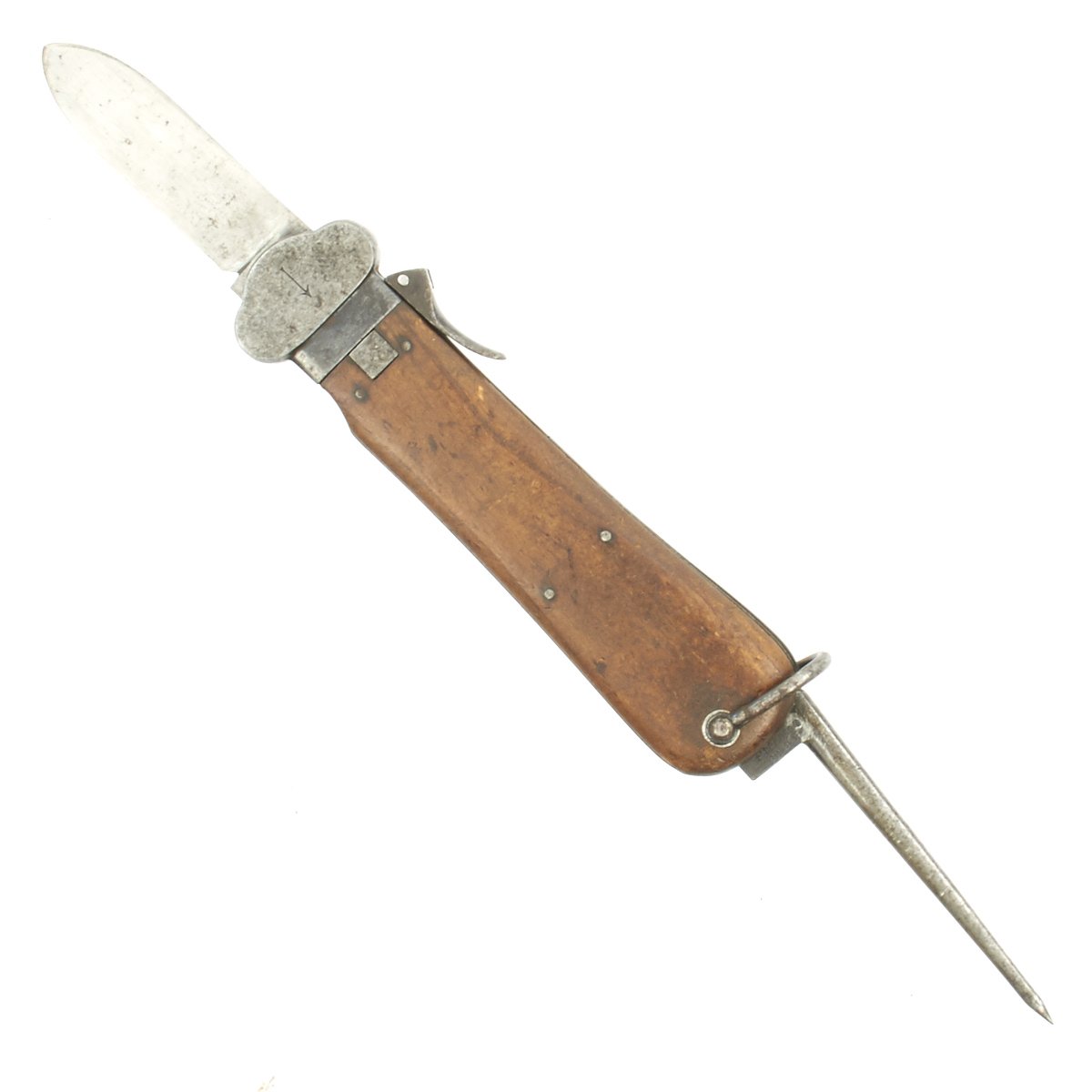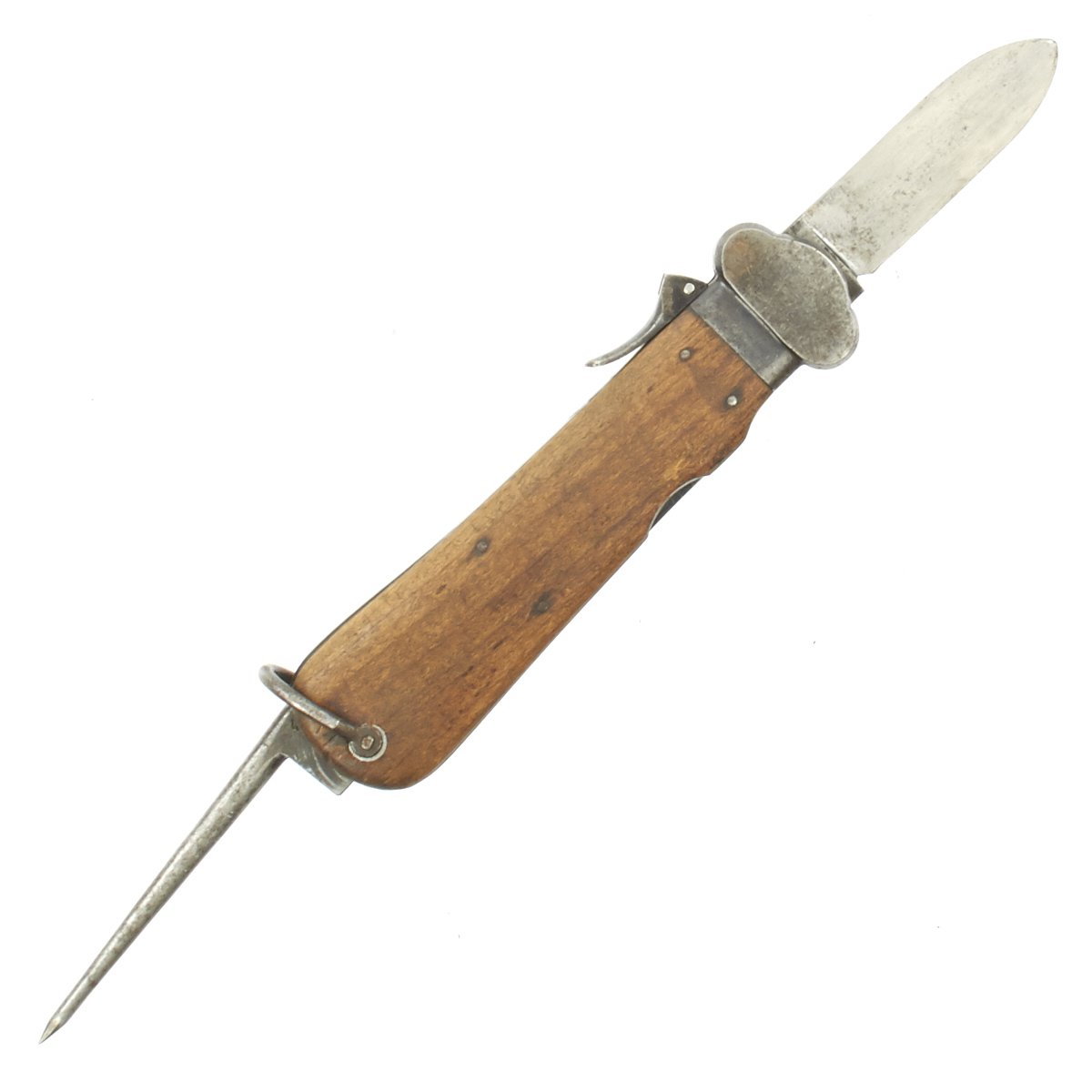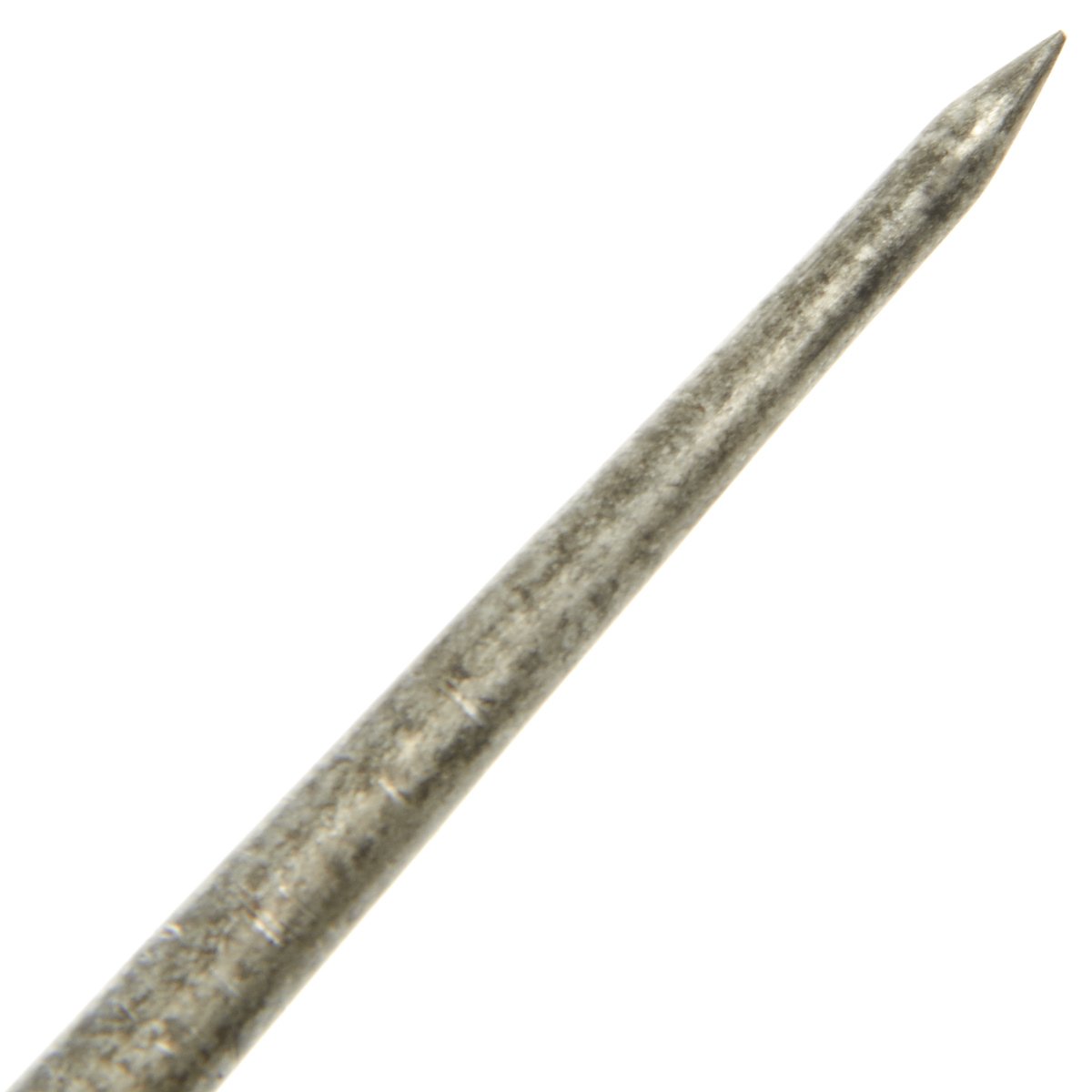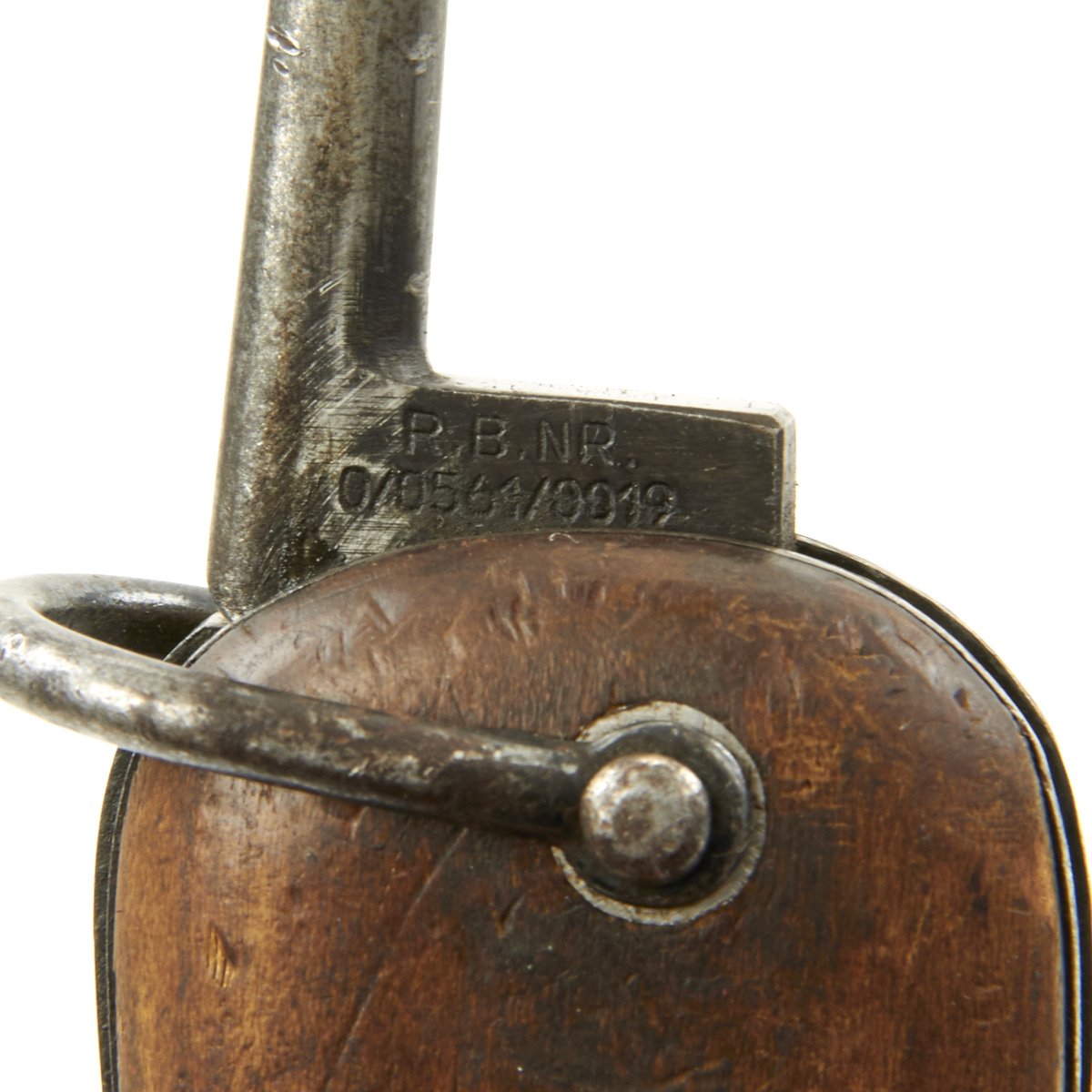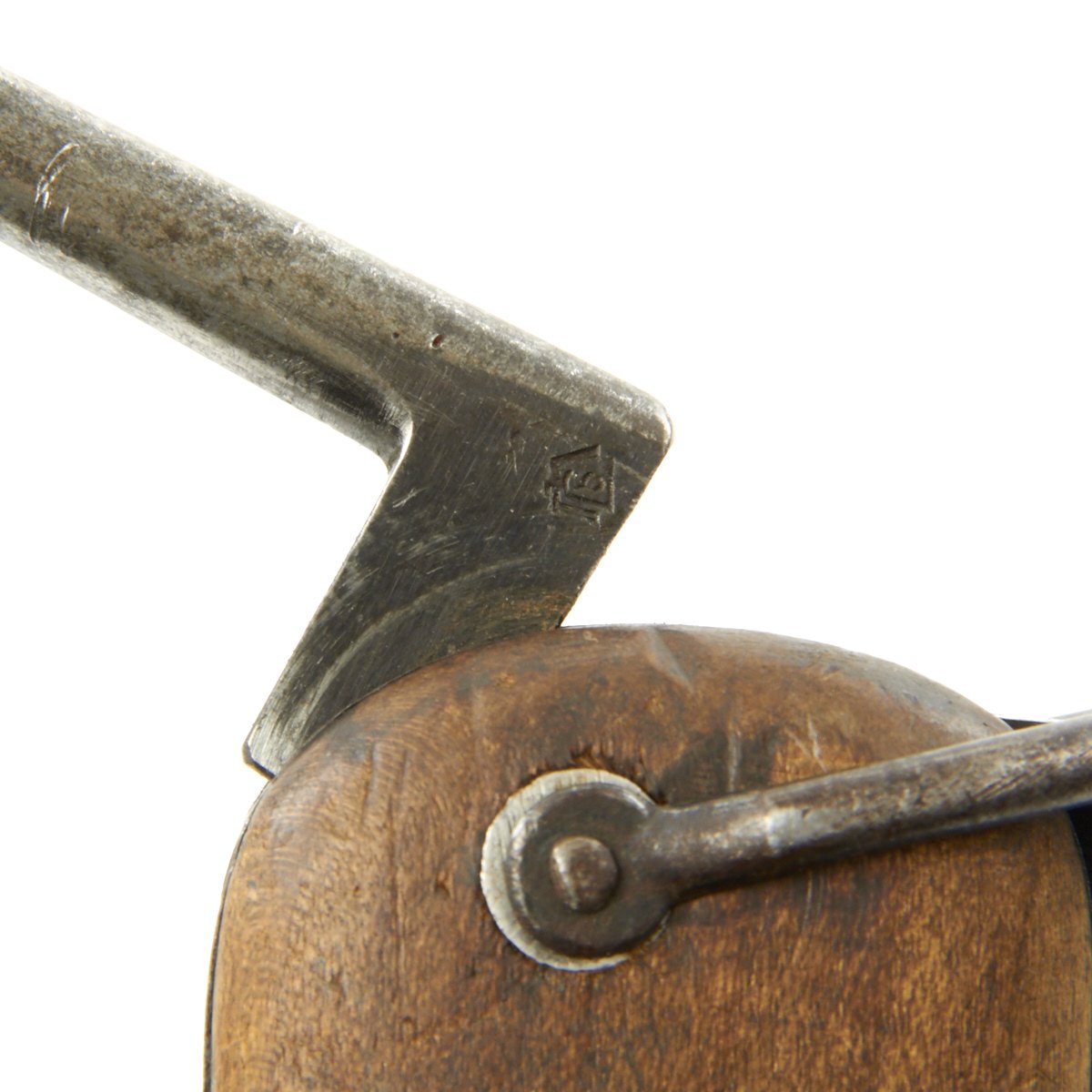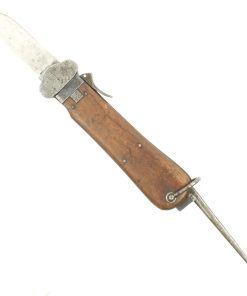Original German WWII Late War Luftwaffe Take Down Fallschirmjäger Gravity Knife with Cut-down Blade – Solingen Made Original Items
$ 395,00 $ 118,50
Original Item: Only One Available. This is an interesting cut-down example of a late-war produced Type II “Take down” version of the legendary Luftwaffe Fallschirmjäger-Messer, or German air force paratrooper knife (FJM or FKm), with a Solingen RB Nr on the blade. These knives normally utilize a four-inch (100 mm) telescoping (OTF), gravity-propelled locking blade, however this example has had the blade length reduced to 2 5/8 inches. First produced in 1937, the FJM was issued to German flight crews and paratroops, primarily for the purpose of cutting a trapped parachutist from his rigging in case he landed with a tangled parachute, or became entangled in trees with the shroud lines. Though not intended for use as a fighting knife, the FJM’s blade could be and was used as a close combat weapon when necessary.
The Luftwaffe Fallschirmjäger-Messer uses a sliding blade inside a metal gripframe, which was originally fitted with smooth wood scales, usually of beech or walnut. The blade itself is a relatively blunt spear-point, and the profile is flat ground, tapering to a utility edge. To open the blade, the user points the FJM downwards while flipping up the fulcrum-style operating lever, allowing gravity to draw out the blade to its fullest extent. Releasing the lever locks the blade into position. The FJM may also be opened by flipping the blade release lever while flicking the wrist holding the knife, causing the blade to extend. The FJM was also equipped with a folding marlinspike or awl. Primarily intended for untangling rope knots, it can also be used as a prying tool. The FJM’s spike does not lock when opened and was never intended to be used as a combat weapon, though individual German paratroopers may have employed it as such.
There are three principal types of wartime-era Luftwaffe Fallschirmjäger-Messers. The Type I FKm has wood scales (handle), was made from 1937-1941, and unlike successive models, has no ‘takedown’ capability. The Type II FKm is the same knife, but with takedown features, and was produced from 1941 to the end of World War II.
This example of the Type II FKm (FJM) is in good condition, and is has a fine carbon steel blade, with anodized and plated steel components making up the rest of the knife. Due to wear and use, the plating on the exterior components has worn off, though the anodizing on the internal components is still in nice shape. The number 1215 is stamped on bottom of cross guard, the blade base, and on the inside of inside of blade slide, so this knife has not had parts replaced. The number 266 is stamped on both parts of the blade lock, which needs to be pushed down relatively far to release the blade. There is also arrow on cross guard and interior to indicate the correct orientation when reassembling the knife.
The “take-down” ability allows the cross guard to be removed, and the body/sheath opens with the end ring as a hinge. The blade can then be removed for servicing, and the interior can be cleaned to ensure the blade moves freely. On this example, the take-down ability functions perfectly, and the release and marlinspike springs are intact with no cracks. This is a fully functional example, with the only real issue being the cut down blade. Most likely it broke at some point, as the blades were not very strong, being intended mainly for slicing through rope.
The grip plates are of walnut with the standard four retaining rivets on each side. These plates are in good condition throughout, with a very attractive wood grain. The base of the marlinspike has an additional marking on it, indicating the manufacturer of the knife:
R.B.NR.
0/0561/0019
German RB Numbers, or Reichsbetriebsnummer, also known as the National Business Number, were an alternative to the 3 letter codes in use late in the war. The first number 0 is the prefix for “industry”, while 0561 is the location code for Solingen, the largest and best blade producing city in Germany. From what we can tell from records, contractor 0019 is thought to be Paul Weyersberg, a well known name in Solingen, who had produced large numbers of the Type 1 knife. There is unfortunately not much information out there on the RB number system.
The take-down version of the gravity knives are becoming extremely difficult to locate. This is only the second example that we have had in decades of business. Ready to display!
Fast Shipping with Professional Packaging
Thanks to our longstanding association with UPS FedEx DHL, and other major international carriers, we are able to provide a range of shipping options. Our warehouse staff is expertly trained and will wrap your products according to our exact and precise specifications. Prior to shipping, your goods will be thoroughly examined and securely secured. We ship to thousands clients each day across multiple countries. This shows how we're dedicated to be the largest retailer on the internet. Warehouses and distribution centres can be located throughout Europe as well as the USA.
Note: Orders with more than one item will be assigned a processing date depending on the item.
Before shipping before shipping, we'll conduct a thorough inspection of the items you have ordered. Today, the majority of orders will be delivered within 48 hours. The delivery time will be between 3-7 days.
Returns
The stock is dynamic and we cannot completely manage it because multiple stakeholders are involved, including our factory and warehouse. So the actual stock may alter at any time. It's possible that you may not receive your order once the order has been made.
Our policy is valid for a period of 30 days. If you don't receive the product within 30 days, we are not able to issue a refund or an exchange.
You can only return an item if it is unused and in the same state as the day you received it. You must have the item in its original packaging.
Related products
Uncategorized
Uncategorized
Uncategorized
Uncategorized
Uncategorized
Armored Burgonet Helmet & Polearm from Scottish Castle Leith Hall Circa 1700 Original Items
Uncategorized
Band of Brothers ORIGINAL GERMAN WWII Le. F.H. 18 10.5cm ARTILLERY PIECE Original Items
Uncategorized
Uncategorized
Uncategorized
Uncategorized
Uncategorized
Uncategorized
Uncategorized
Uncategorized
Uncategorized
Uncategorized
Uncategorized
